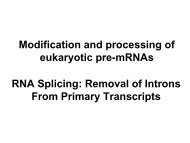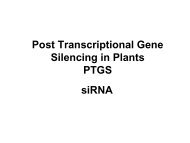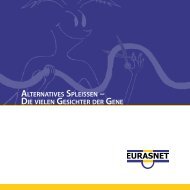You also want an ePaper? Increase the reach of your titles
YUMPU automatically turns print PDFs into web optimized ePapers that Google loves.
Partner 13 has extensively studied the U7 snRNP involved in histone RNA 3' end processing and its assembly,which is mediated by the SMN complex. For several years this partner has engineered modified U7 version(called U7 SmOPT) which no longer function in maturation of histone pre-mRNA but can carry antisenssequences. U7 SmOPT-derived RNA equipped with antisense sequences targeting specific splice sites should beideally suited to manipulate the splicing patterns of individual target genes. Moreover, being embedded intosnRNP particles, intracellularly expressed antisense sequences should be highly stable and resistant tonucleases. These vectors prove to be useful tools to induce exon skipping in several pathological modelsincluding β-globin gene in β-thalassimia, dystrophin gene in DMD, the cyclophilin A gene and the multiplyspliced HIV-1 transcripts. However, this approach has never been tested in the context of exon inclusion.Since it has been hypothesised that the SMN2 C>T transition in exon 7 abolishes an ESE, Partner 19 designedan innovative strategy aimed at reintroducing an exogenous SF2/ASF binding site at the SMN2 exon 7 3'-ss.They rely on a so-called bifunctional oligonucleotide carrying an ESE tail linked to an antisense sequencenecessary for specific targeting (TOE). Partner 13 adapted this principle by combining an antisense U7 snRNAwith an additional ESE sequence capable of binding SF2/ASF. This strategy proved very efficient resulting inan exon 7 inclusion level superior to 30% in transient transfection. When integrated into stable Hela-SMN-LucFcell lines through a lentiviral vector, this construct even allows for a long term correction reaching 50%inclusion.To test the efficacy of this novel modified U7, Partner 13 has introduced in his lab a very severe mouse modelfor SMA where symptoms are clearly reduced and survival of the animals is prolonged. Moreover Partner 13has made significant progress towards engineering inducible U7 snRNA cassettes. The plan for the next 18months will be to introduce modified U7 in the model mice and test the efficacy of SMN2 correction.Work Package 15: Development of Enabling TechnologiesSeveral new technologies were investigated to enable a more complete and detailed understanding of alternativesplicing. Some feasibility studies revealed limits of technologies (e.g., D2 bombardment, improvement ofprotein-RNA cross-linking, partner 1c). Alternative strategies will be explored (see future plans below).Important progress has been achieved in mass spectrometry analysis of RNA-protein cross-links (partner 1a).This strategy should be useful for many partners in the NOE. Similarly, constructs for stable expression oftagged mRNA species, for studies on alternative splicing and targeted, post-transcriptional RNA modificationare now available (partners 1b, 3 and 10b). Development of enabling technology was also pursued in manyunanticipated directions, due to new need in specific areas, this included:- establishing splicing-sensitive microarray designs and data analysis (partner 2)- improving TAP tag purification and developing new protein interaction assays (partner 12b)- developing FLIM-FRET techniques for analyzing the interactions of protein splicing factors in vivo.- implementing new proteomics approaches for analyzing protein interaction partners using quantitativemass spectrometry.Future plans/new JPA1) Highly accurate ESI FT MS of cross-linked species will be performed. The exact masses of the cross-linkedspecies, determined in this way, will serve as input information for the identification of the cross-linked peptidespecies: The exact mass and marker ions derived from the cross-linked peptide and RNA moiety will allow theidentification of cross-linked species by database search using an appropriate search engine. This informationwill help all <strong>EURASNET</strong> collaborator and groups outside the network to map protein-RNA cross-links.2) Enrichment strategies for cross-linked RNA-peptides will be used to identify cross-linked proteins/peptides incore 12S U2 snRNP, tri-snRNPs and spliceosomal B and C complexes. A similar enrichment strategy will beused to systematically investigate proteins with RRM domains complexes with various RNAs (collaborationbetween H. Urlaub (partner 1c) and F. Allain (partner 29). Such a systematic study will help (in the absence ofhighly resolved 3D protein–RNA structures) to elucidate the “code” of RNA interaction mediated by RRMdomains.3) Mass spectrometry-based identification and characterization of isoforms of spliceosomal proteins involved in(alternative) splicing: we plan to identify subsets of isoforms of proteins by multiple reaction monitoring221







